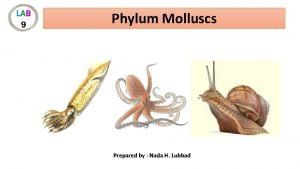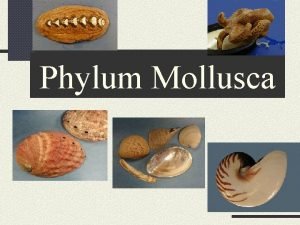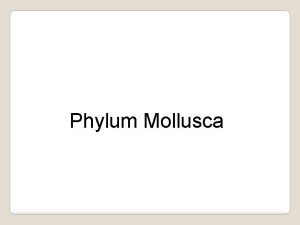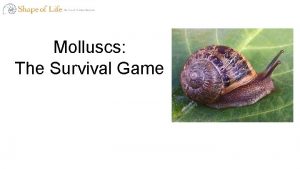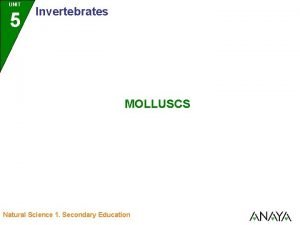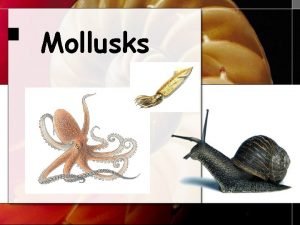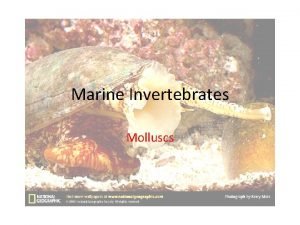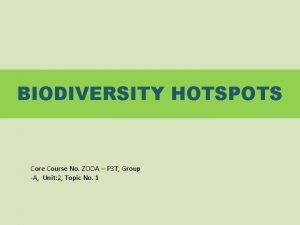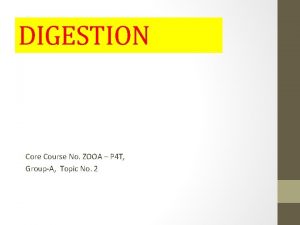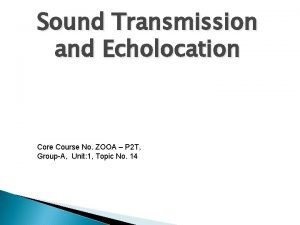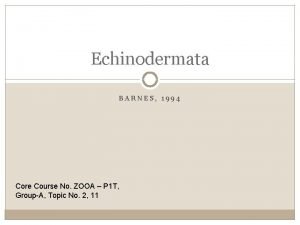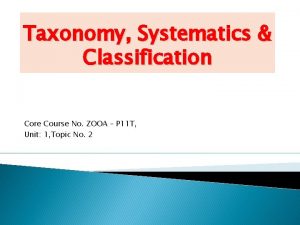NERVOUS SYSTEM IN MOLLUSCS Core Course No ZOOA





















- Slides: 21

NERVOUS SYSTEM IN MOLLUSCS Core Course No. ZOOA – P 1 T, Group-A, Topic No. 10

Various classes Gastropoda (snails) Cephalopoda (octopus, squid, nautilus) Bivalvia (clams, mussels) Aplacophora Monoplacophora Polyplacophora (chitons) Scaphopoda (tusk shells) Ruppert and Barnes (1994)

Basic Plan Ø 6 pairs of ganglia Ø CNS = Circum oesophageal nerve ring Ø Cerebral, Pleural and Pedal ganglia (1 Pair each) and connectives and commissures Ø Cerebral = Head, Pedal= foot, Pleural = mantle Cerebral Ganglion Buccal Ganglion Pleural Ganglion Pedal Ganglion Ø PNS Ø Buccal, Parietal and Visceral ganglia(1 pair each) and 1 pair each of buccal, visceral and parietal connectives and commissures Buccal= Buccal mass, Visceral = intestine, Parietal = other parts of alimentary system Monoplacophores ü Cerebral commissure surrounding mouth ü One pair each of pedal and lateral cords from the commissure ü Simplest Parietal Ganglio Visceral Ganglio

Polyplacophora (Chiton) ü Simple ü Devoid of ganglia (only swelling) ü Oesophageal nerve ring ü Pedal and Palliovisceral cords (1 pair each) ü Transverse commisure in between both pairs of cords

Aplacophorans ü Simple nerve ring with pedal and palliovisceral nerve cord (1 pair each) ü Cerebral ganglia ü Single (Neomenia) ü Double but fused (Chaetoderma) ü Pedal, Pleural, buccal and visceral ganglia paired Cerebral G Pleural G Buccal G Pedal G

Scaphopoda (Dentilium) ü Ganglionated ü Cerebral G paired, close proximity, short commissure ü Pleural G paired, close to CG and connected via Cerebro-Pleural connectives ü Pedal G paired, close to each other on front part of foot ü Visceral G fused in front of anus ü Pleuropedal connectives CG fuse Cerebropedal ones PLG PDG VG

Gastropods Basic Plan and effect of torsion ü Ganglionated, Well developed ü Concentrated in head ü 6 pairs ganglia ü Due to torsion asymmetric

Effect of torsion

Prosobranchia Twisted Pleuro-Parietal connectives due to torsion of visceral mass CHIASTO/ STREPTONEURY R-PLG lie left, dorsal to gut and known as Supra-intestinal ganglia L-PLG lies on right below the gut, thus Infra-intestinal ganglia Side reversal of PLG visceral looptwist in 8 like figure

DIALYNEURY Modified streptoneury Nerve from PLG and Supra intestinal ganglia anastomose Triton ZYGONEURY Modified Dialyneury Mantle nerve from PLG connects directly to Supra IG, often on right Cassidaria GANGLIA and CONNECTIVES All ganglia except VG conc near and below CG Twisted Viscero-Parietal connectives Buccinum

Opisthobranchia Euthyneury, restored symmetry due to detorsion of visceral mass All except VG conc cerebral position Viscero-Prietal connective untwisted Pulmonata Euthyneury, All Ganglia conc around oesophagus to form a circumoesophageal ring Short Connectives commissures and

Bivalves ü Simple, Ganglionated, bilaterally symmetrical ü 3 pairs ganglia, connectives, commissures and principal nerves ü Cerebro-Pleural G – paired, cose or apart, oesophageal margin ü Pedal G – paired, in visceral mass ü Viscero-Parietal G – paired, below posterior adductor muscles ü One pair conective from CPG to VPG ü Another pair from CPG to PG ü Pallial, anterior adductor and buccal nerves from CPG ü Pedal nerves from PG ü Branchial, posterior adductor from VP

CEPHALOPODA ü Most complex among all the invertebrates ü Ganglia concentrate to form Brain, although Circumoesophageal structure yet complex ü Compact brain in cartilagenous capsule ü Multiple lobes of brain

CEPHALOPODA Inferior buccal G – upper beak, oesophagus, gastric ganglion Superior Buccal lobe – low beak, post salivary glands Branchial lobe - arms and suckers Pedal lobe - funnel, eye, capsule Optic lobe - eye Pallio Visceral lobe- mantle collar, ink gland, renal, reproductive org, ctenidia etc

Coeloidea (Octopus, Sepia) ü Cerebral G fused ü Optic G well dev ü Pedal G splits into Branchial G ü Pleuro-Visceral G united ü All G fused to form brain ü Large distinct lobes in Brain

Nautiloidea (Nautilus) ü G con near head region forming CIRCUM OESOPHAGEAL COLLAR ü Brain without distinct lobes ü COLLAR Distal - Cerebral G Ant Ventral- Pedal G Post vntrl- Pleuro visceral G Buccal and Labial G superior to the COLLAR





Sources Ø E. E. Ruppert et al. , Invertebrate Zoology , 7 th Edition, Cengage Learning, 2004 Ø R. C. Brusca and G. J. Brusca. , Invertebrates, 2 nd Edition, Sinaur Associates, 2003 Ø B. B. Ganguly et al. , Biology of Animals Volume I, 3 rd Edition, New Central Book Agency, 2011.
 Neuronal pool
Neuronal pool Sensory input and motor output
Sensory input and motor output Processes of neuron
Processes of neuron Nephridia in molluscs
Nephridia in molluscs What is visceral mass in molluscs
What is visceral mass in molluscs Symmetry of mollusca
Symmetry of mollusca What’s the moon snail’s strategy to catch the cockle?
What’s the moon snail’s strategy to catch the cockle? Molluscs
Molluscs Mollusks characteristics
Mollusks characteristics Nervous system and digestive system
Nervous system and digestive system Endocrine system vs nervous system
Endocrine system vs nervous system Mechanism of action of hormones
Mechanism of action of hormones Endocrine system
Endocrine system The brittle, rocky outer layer of earth
The brittle, rocky outer layer of earth Earth mantle definition
Earth mantle definition Which layer is the least dense
Which layer is the least dense Core capabilities and core rigidities
Core capabilities and core rigidities What is a core gpa
What is a core gpa What is half brick wall
What is half brick wall Course number and title
Course number and title Chaine parallèle muscle
Chaine parallèle muscle Chemical messengers of the nervous system
Chemical messengers of the nervous system



